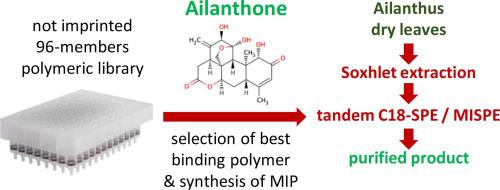当前位置:
X-MOL 学术
›
Microchem. J.
›
论文详情
Our official English website, www.x-mol.net, welcomes your feedback! (Note: you will need to create a separate account there.)
Selective enrichment of ailanthone from leaves of ailanthus altissima by tandem reverse phase / molecularly imprinted solid phase extraction
Microchemical Journal ( IF 4.8 ) Pub Date : 2020-11-01 , DOI: 10.1016/j.microc.2020.105198 Laura Anfossi , Cristina Giovannoli , Fabio Di Nardo , Simone Cavalera , Matteo Chiarello , Francesco Trotta , Claudio Baggiani
Microchemical Journal ( IF 4.8 ) Pub Date : 2020-11-01 , DOI: 10.1016/j.microc.2020.105198 Laura Anfossi , Cristina Giovannoli , Fabio Di Nardo , Simone Cavalera , Matteo Chiarello , Francesco Trotta , Claudio Baggiani

|
Abstract The biological activity of extracts from Ailanthus altissima is mainly due to the presence of ailanthone, a compound belonging to the quassinoid class. Recently, attention has been paid to its strong cytostatic activity. However, the extraction of ailanthone is based on very long and demanding procedures, which keep the price of the commercial product very high. Thus, the development of selective adsorbents for the purification of ailanthone from A. altissima leaves extracts could help in reduce the costs of production. In this work, we describe the rational design of a molecularly imprinted polymer selective for ailanthone based on the screening of a 96-members not-imprinted polymeric library to rapidly identify pre-polymerization mixtures able to generate MIPs with enhanced binding properties. A 4-vinylpyridine-co-trimethylolpropane trimethacrylate polymer showed high binding towards ailanthone. It was used to prepare an imprinted polymer with acetonitrile showed interesting binding affinity (Keq = 18.3 × 103 L mol−1), high imprinting factor (IF = 3.8) and fast binding kinetics (kass = 0.390 min−1, kdis = 0.021 mol L−1 min−1). The imprinted polymer was used to develop a successful purification protocol of extracts from Ailanthus altissima leaves. The purification was based on the combination of a preliminary clean-up of Soxhlet extracts onto a reverse phase-C18 cartridge and the subsequent isolation of ailanthone by a molecularly imprinted solid phase extraction. This approach allowed efficiently purifying the ailanthone contained in aqueous or methanolic Soxhlet extracts with high yields compared to the quantities reported in literature (water: 0.756 ± 0.027 mg g−1; methanol: 0.770 ± 0.030 mg g−1). Moreover, it allows processing sample volumes up to 15 mL without significant losses of the target compound.
中文翻译:

串联反相/分子印迹固相萃取法选择性富集臭椿叶中的臭椿酮
摘要 臭椿提取物的生物活性主要是由于臭椿酮的存在,臭椿酮属于类苦甙类。最近,人们注意到其强大的细胞抑制活性。然而,臭椿酮的提取是基于非常漫长和苛刻的程序,这使得商业产品的价格非常高。因此,开发用于从 A. altissima 叶提取物中纯化臭椿酮的选择性吸附剂有助于降低生产成本。在这项工作中,我们描述了基于筛选 96 个成员的非印迹聚合物库以快速识别能够生成具有增强结合特性的 MIP 的预聚合混合物,从而合理设计了对臭葱酮具有选择性的分子印迹聚合物。4-乙烯基吡啶-共-三羟甲基丙烷三甲基丙烯酸酯聚合物显示出对臭椿酮的高结合。它用于制备带有乙腈的印迹聚合物,显示出有趣的结合亲和力(Keq = 18.3 × 103 L mol-1)、高印迹因子(IF = 3.8)和快速结合动力学(kass = 0.390 min-1,kdis = 0.021 mol L−1 min−1)。印迹聚合物用于开发臭椿叶提取物的成功纯化方案。纯化基于在反相 C18 柱上对索氏提取物进行初步净化和随后通过分子印迹固相萃取分离臭椿酮的组合。与文献中报道的数量(水:0.756 ± 0.027 mg g-1;甲醇:0.770 ± 0.030 mg g-1)相比,这种方法允许以高产率高效纯化水性或甲醇索氏提取物中所含的臭草酮。此外,它允许处理高达 15 mL 的样品体积,而不会显着损失目标化合物。
更新日期:2020-11-01
中文翻译:

串联反相/分子印迹固相萃取法选择性富集臭椿叶中的臭椿酮
摘要 臭椿提取物的生物活性主要是由于臭椿酮的存在,臭椿酮属于类苦甙类。最近,人们注意到其强大的细胞抑制活性。然而,臭椿酮的提取是基于非常漫长和苛刻的程序,这使得商业产品的价格非常高。因此,开发用于从 A. altissima 叶提取物中纯化臭椿酮的选择性吸附剂有助于降低生产成本。在这项工作中,我们描述了基于筛选 96 个成员的非印迹聚合物库以快速识别能够生成具有增强结合特性的 MIP 的预聚合混合物,从而合理设计了对臭葱酮具有选择性的分子印迹聚合物。4-乙烯基吡啶-共-三羟甲基丙烷三甲基丙烯酸酯聚合物显示出对臭椿酮的高结合。它用于制备带有乙腈的印迹聚合物,显示出有趣的结合亲和力(Keq = 18.3 × 103 L mol-1)、高印迹因子(IF = 3.8)和快速结合动力学(kass = 0.390 min-1,kdis = 0.021 mol L−1 min−1)。印迹聚合物用于开发臭椿叶提取物的成功纯化方案。纯化基于在反相 C18 柱上对索氏提取物进行初步净化和随后通过分子印迹固相萃取分离臭椿酮的组合。与文献中报道的数量(水:0.756 ± 0.027 mg g-1;甲醇:0.770 ± 0.030 mg g-1)相比,这种方法允许以高产率高效纯化水性或甲醇索氏提取物中所含的臭草酮。此外,它允许处理高达 15 mL 的样品体积,而不会显着损失目标化合物。


























 京公网安备 11010802027423号
京公网安备 11010802027423号